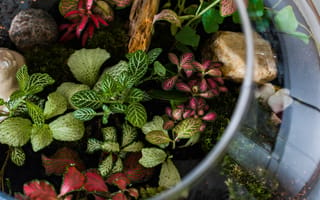Self-sustaining terrariums are a masterclass in social responsibility. Lemon button fern, dwarf arrowhead and golden pothos encased in glass, watered once and placed near a north-facing window will thrive — without human intervention — each element hard at work sustaining life.
Much like symbiotic plants in a terrarium, humans thrive in the presence of collective responsibility. A study published in The Sustainability Accounting, Management and Policy Journal suggests that employees, provided communal responsibility and autonomy, will demonstrate higher productivity than their micromanaged counterparts.
This knowledge has made it easy for forward-thinking tech companies to invite employees to work in their vivarium of choice. When Built In sat down with five Austin tech leaders, it was clear that the future of work lies in an autonomy-first approach to growing the hybrid workplace.
ePayPolicy Director of People Operations Allyson Hoffman called it an efficiency-first approach: “By placing efficiency first, we honor that there are weeks where personal matters don’t allow for much in-person collaboration — and that there are just times where being remote is better for mental health.”
“We have created a work environment that puts the responsibility into the hands of the employee,” Pushnami CEO Emerson Smith said.
In a choose-your-own-workspace model, how can leadership select the right employees to support their company ecosystem?
“We want folks whose first thought is: ‘How can I support and help my team succeed?’” said NinjaOne CRO Dean Yeck
Whether it’s glass jars or glass offices, the vessel of the terrarium doesn’t matter — only that each element is equipped to tackle its respective duties. For these five Austin tech leaders, what matters most is that their employees are empowered to bloom where they wish.
WP Engine is a software company committed to open source and exceptional customer service to the WordPress community.
Would you describe your current work model as “remote-first,” “office-occasional” or “office-first?”
Shortly after following the lockdown in March 2020, we shifted our work model to a remote-first organization. After speaking with employees, conducting internal surveys and looking at the wellness of our employees, we found that a remote-first model was not only sustainable but healthy for WP Engine as a whole.
In 2021 we launched the “Future of Work’’ program at WP engine. This program gives each employee the flexibility to work from a local hub office or from the convenience of home.
With our remote-first model, employees have been able to be where they’re needed most, without having to leave or miss a beat at work. We’ve also been able to expand the reach of our talent pool, hiring amazing people from all over the world for our openings.
Employees have been able to be where they’re needed most”
How often are employees expected to come into the office, and why does this schedule work for your company?
They can come to the office whenever they want to or need to for a meeting or event. As we’ve begun to reopen our offices we’ve shifted our focus from traditional offices to hubs. Hubs, for us, are offices located in our top regions where employees can gather to socialize, collaborate and participate in meetings, book desks for focus time or just get away from home for the day.
For teams located in the same hub, teams can meet up in person but we still ask all employees to use individual laptops for meetings so those remote team members can feel included. This remote-first model works for WP Engine because when our employees are happy and healthy, our business is healthy as well.
What are the key cultural and organizational ingredients that make your hybrid model work?
At WP Engine our core values influence all that we do. Doing the right thing is one of our core values. We believe this key value has helped us understand the needs of our employees and customers and build a model that works for them.
Being a global organization means that — even before 2020 — we were working with colleagues virtually all over the world. That structure made the transition to remote-first much easier.
NinjaOne is a software company providing unified IT operations solutions.
Would you describe your current work model as “remote-first,” “office-occasional” or “office-first?”
NinjaOne has always been a remote-first company — with more than half of our staff working remotely full-time. At our Austin headquarters and regional hubs in Tampa, Berlin and Sydney, we have dedicated office space for employees that want to have an in-person experience.
Today, most of our marketing and sales teams are located near these hubs and teams will typically come in two to three days a week, though they are not required to be in the office.
We encourage our employees to work wherever they are most comfortable and do everything we can to accommodate their needs. We provide laptops and office equipment and we’ve mastered the art of remote collaboration, so new employees can focus on ramping up into their new roles and learning everything they can about NinjaOne.
Our training department is one part of the business that’s made being a remote-first company effective. We’ve developed a massive internal knowledge base that contains everything an employee needs. We also utilize a learning management system that helps employees hone their skills, develop new ones and progress their careers.
We’ve mastered the art of remote collaboration.”
How often are employees expected to come into the office, and why does this schedule work for your company?
Employees aren’t expected to come into the office a certain number of days a week. Each team has the discretion to figure out a system that works best for them — whether that means teams only come in only for important meetings, a certain number of days a week or never come in.
For teams located near our office hubs, it’s typical for a few people to come into the office throughout the week. But they come in because they want to be around their fellow coworkers, not because they have to. More than half of our employees are fully remote and we extend this flexibility to everyone.
This flexibility has proven to be extremely beneficial for the business as it’s allowed us to find and hire great talent all over the country. In the last year, we nearly doubled our employee headcount and we expect to reach more than 600 employees by the end of the year — all while being a remote-first company.
What are the key cultural and organizational ingredients that make your hybrid model work?
It comes down to a culture of cooperation and the belief that everybody is a product manager. As a fast-moving organization, we place a great deal of trust in our employees and give them the autonomy to accomplish their tasks in their own way.
Everybody being a product manager means that we have a sense of ownership in our work and constantly seek new solutions. Our culture is to pursue constant innovation. We challenge ourselves to identify new opportunities and take a methodical approach toward building the best solution possible.
This philosophy is ingrained throughout the company and has spurred on new products and features, new avenues to grow the business and improved workflows that enable all of our teams to be their most effective.
ePayPolicy is a fintech company aiming to make customers’ lives easier with integrated payment solutions.
Would you describe your current work model as “remote-first,” “office-occasional” or “office-first?”
Our current hybrid model falls somewhere between culture-first and efficiency-first. There are some teams, like sales, that traditionally do better in person with the buzz and constant collaboration offered by being in person. Other teams, and even other personalities for that matter, work better more independently and offsite where they can focus on a set of tasks.
Allowing our teams to work however they are most productive has struck a natural balance. There has been absolutely no sacrifice in production or performance.
Allowing our teams to work however they are most productive has struck a natural balance.”
How often are employees expected to come into the office, and why does this schedule work for your company?
Each team sets their own schedule, but we do maintain a company-wide policy .
CARE CARD: EPAY’S REMOTE POLICY
- Three days per week in the office
- Two days remote
- Exemptions for those on medical accommodation
What are the key cultural and organizational ingredients that make your hybrid model work?
Trust, collaboration, openness and valuing overall wellness above anything else. We have always offered unlimited PTO and operate very much under a family first edict — whatever your family may look like.
We honor that there are weeks where personal matters don’t allow for as much in person collaboration as you’d like, or there are just times where being remote is better for your mental health. Staying flexible and keeping the lines of communication open along with crystal- clear expectations makes it work for us.
Pushnami is an advertising and engagement platform that delivers messages through browser-based push notifications and email.
Would you describe your current work model as “remote-first,” “office-occasional” or “office-first?”
I would say we use a personal choice model. We do not promote any model over the other. Instead, it really is up to the employee and what works best for them. Some employees like to work in the office most days, others every once in a while and some prefer to just stay at home.
We use a personal choice model.”
How often are employees expected to come into the office, and why does this schedule work for your company?
No one is ever required to come into the office. We believe in treating our team like adults, which includes letting them set their own work schedules. By focusing on productivity, we have created a work environment that puts the responsibility in the hands of our employees.
What are the key cultural and organizational ingredients that make your hybrid model work?
Switching to a remote environment is not easy for any company. You have to make sure there is still a culture to promote teamwork, interaction and innovation — which requires constant effort and investment into constant improvement.
One of the big factors is making sure that any employee we hire matches our culture in regards to work and ethics. Being independent and a self starter, having goals in life and being a genuinely good person are important qualities for anyone working at Pushnami.
TrustRadius is an enterprise web company and trusted platform for B2B customer reviews.
Would you describe your current work model as “remote-first,” “office-occasional” or “office-first?”
Our work styles lean towards “remote-first.” The majority of our employees prefer an option to be remote — and many do not live within the Austin metro area.
When we considered whether or not to reopen an office, we decided to take the approach of ensuring as much flexibility as possible. This included options to continue working remotely, as well as providing them with a beautiful office space in the Austin Hill Country. They can enjoy the space for meetings, team building events and co-working opportunities.
We also plan to utilize our office space for hosting in-person events for our vendors and tech buyers in our community to help close the disconnect between the two groups.
Proactively focus on expectations and outcomes rather than work schedules and office use.”
How often are employees expected to come into the office, and why does this schedule work for your company?
Our stance has been to proactively focus on expectations and outcomes rather than work schedules and office use. There are no requirements for any employee to be in the office at any time. As long as goals are being set, approved and met, we are not dictating work schedules within an office environment.
We have some groups that we see in the office every week. It works for them, and while they are here, we want them to have a great experience. We maintain everything from ease of AV equipment to a stocked kitchen.
Other groups just recently visited our office for the first time since they began employment with us over a year ago. Either way, we support what is best for individuals through engaged communication regarding performance expectations.
What are the key cultural and organizational ingredients that make your hybrid model work?
One of our core values at TrustRadius is being human. The best way for us to exercise this core value is to continue our support of employees as human beings — including work schedules and office use. By allowing for this flexibility, we keep in alignment with our values and focus on how respecting the human experience in a workplace can drive cultural excellence.














